Tennessee

Tennessee

| State of Tennessee | |
| Nickname(s): | |
| Motto(s): | |
| Anthem:Nine songs | |
| Country | United States |
|---|---|
| Before statehood | Southwest Territory |
| Admitted to the Union | June 1, 1796 (16th) |
| Capital | Nashville[1] |
| Largest metro | Greater Nashville |
| Government | |
| •Governor | |
| •Lieutenant Governor | |
| Area | |
| • Total | 42,143 sq mi (109,247 km) |
| • Land | 41,217 sq mi (106,846 km) |
| • Water | 926 sq mi (2,400 km) 2.2% |
| Area rank | 36th |
| Dimensions | |
| • Length | 440 mi (710 km) |
| • Width | 120 mi (195 km) |
| Elevation | 900 ft (270 m) |
| Highest elevation | 6,643 ft (2,025 m) |
| Lowest elevation | 178 ft (54 m) |
| Population | |
| • Total | 6,833,793 (2,019 est.)[4] |
| • Rank | 16th |
| • Density | 159.4/sq mi (61.5/km) |
| • Density rank | 20th |
| •Median household income | $51,340[5] |
| • Income rank | 42nd |
| Demonym(s) | TennesseanBig Bender(archaic)Volunteer(historical significance) |
| Language | |
| •Official language | English |
| •Spoken language | Language spoken at home[6] |
| Time zones | |
| East Tennessee | UTC-05:00(Eastern) |
| UTC-04:00(EDT) | |
| MiddleandWest | UTC-06:00(Central) |
| UTC-05:00(CDT) | |
| USPS abbreviation | |
| ISO 3166 code | US-TN |
| Trad. abbreviation | Tenn. |
| Legislature | General Assembly |
| •Upper house | Senate |
| •Lower house | House of Representatives |
| U.S. senators | |
| U.S. House delegation | 7 Republicans 2 Democrats (list) |
| Latitude | 34° 59′ N to 36° 41′ N |
| Longitude | 81° 39′ W to 90° 19′ W |
| Website | |
Tennessee (/ˌtɛnəˈsiː/ ( listen),[7][8] locally /ˈtɛnəsi/;[9] Cherokee: ᏔᎾᏏ, romanized: Tanasi) is a state located in the southeastern region of the United States of America. Tennessee is the 36th largest and the 16th most populous of the 50 United States. Tennessee is bordered by eight states, with Kentucky to the north, Virginia to the northeast, North Carolina to the east, Georgia, Alabama, and Mississippi to the south, Arkansas to the west, and Missouri to the northwest. The Appalachian Mountains dominate the eastern part of the state, and the Mississippi River forms the state's western border. Nashville is the state's capital and largest city, with a 2017 population of 667,560 and a 2017 metro population of 1,903,045. Tennessee's second largest city is Memphis, which had a population of 652,236 in 2017.[10]
The state of Tennessee is rooted in the Watauga Association, a 1772 frontier pact generally regarded as the first constitutional government west of the Appalachians.[11] What is now Tennessee was initially part of North Carolina, and later part of the Southwest Territory. Tennessee was admitted to the Union as the 16th state on June 1, 1796. Tennessee was the last state to leave the Union and join the Confederacy at the outbreak of the American Civil War in 1861. Occupied by Union forces from 1862, it was the first state to be readmitted to the Union at the end of the war.[12]
Tennessee furnished more soldiers for the Confederate Army than any other state besides Virginia, and more soldiers for the Union Army than the rest of the Confederacy combined.[12] Beginning during Reconstruction, it had competitive party politics, but a Democratic takeover in the late 1880s resulted in passage of disenfranchisement laws that excluded most blacks and many poor whites from voting. This sharply reduced competition in politics in the state until after passage of civil rights legislation in the mid-20th century.[13] In the 20th century, Tennessee transitioned from an agrarian economy to a more diversified economy, aided by massive federal investment in the Tennessee Valley Authority and, in the early 1940s, the city of Oak Ridge. This city was established to house the Manhattan Project's uranium enrichment facilities, helping to build the world's first atomic bombs, two of which were dropped on Imperial Japan near the end of World War II. After the war, the Oak Ridge National Laboratory became a key center for nuclear research. In 2016, the element tennessine was named for the state.[14]
Tennessee's major industries include agriculture, manufacturing, and tourism.
Poultry, soybeans, and cattle are the state's primary agricultural products,[15] and major manufacturing exports include chemicals, transportation equipment, and electrical equipment.[16] The Great Smoky Mountains National Park, the nation's most visited national park, is headquartered in the eastern part of the state, and a section of the Appalachian Trail roughly follows the Tennessee-North Carolina border.[17] Other major tourist attractions include the Tennessee Aquarium and Chattanooga Choo-Choo Hotel in Chattanooga; Dollywood in Pigeon Forge; Ripley's Aquarium of the Smokies and Ober Gatlinburg in Gatlinburg; the Parthenon, the Country Music Hall of Fame and Museum, and Ryman Auditorium in Nashville; the Jack Daniel's Distillery in Lynchburg; Elvis Presley's Graceland residence and tomb, the Memphis Zoo, the National Civil Rights Museum in Memphis; and Bristol Motor Speedway in Bristol.
| State of Tennessee | |
| Nickname(s): | |
| Motto(s): | |
| Anthem:Nine songs | |
| Country | United States |
|---|---|
| Before statehood | Southwest Territory |
| Admitted to the Union | June 1, 1796 (16th) |
| Capital | Nashville[1] |
| Largest metro | Greater Nashville |
| Government | |
| •Governor | |
| •Lieutenant Governor | |
| Area | |
| • Total | 42,143 sq mi (109,247 km) |
| • Land | 41,217 sq mi (106,846 km) |
| • Water | 926 sq mi (2,400 km) 2.2% |
| Area rank | 36th |
| Dimensions | |
| • Length | 440 mi (710 km) |
| • Width | 120 mi (195 km) |
| Elevation | 900 ft (270 m) |
| Highest elevation | 6,643 ft (2,025 m) |
| Lowest elevation | 178 ft (54 m) |
| Population | |
| • Total | 6,833,793 (2,019 est.)[4] |
| • Rank | 16th |
| • Density | 159.4/sq mi (61.5/km) |
| • Density rank | 20th |
| •Median household income | $51,340[5] |
| • Income rank | 42nd |
| Demonym(s) | TennesseanBig Bender(archaic)Volunteer(historical significance) |
| Language | |
| •Official language | English |
| •Spoken language | Language spoken at home[6] |
| Time zones | |
| East Tennessee | UTC-05:00(Eastern) |
| UTC-04:00(EDT) | |
| MiddleandWest | UTC-06:00(Central) |
| UTC-05:00(CDT) | |
| USPS abbreviation | |
| ISO 3166 code | US-TN |
| Trad. abbreviation | Tenn. |
| Legislature | General Assembly |
| •Upper house | Senate |
| •Lower house | House of Representatives |
| U.S. senators | |
| U.S. House delegation | 7 Republicans 2 Democrats (list) |
| Latitude | 34° 59′ N to 36° 41′ N |
| Longitude | 81° 39′ W to 90° 19′ W |
| Website | |
Etymology

Monument near the old site of Tanasi in Monroe County
The earliest variant of the name that became Tennessee was recorded by Captain Juan Pardo, the Spanish explorer, when he and his men passed through an American Indian village named "Tanasqui" in 1567 while traveling inland from South Carolina. In the early 18th century, British traders encountered a Cherokee town named Tanasi (or "Tanase") in present-day Monroe County, Tennessee. The town was located on a river of the same name (now known as the Little Tennessee River), and appears on maps as early as 1725. It is not known whether this was the same town as the one encountered by Juan Pardo, although recent research suggests that Pardo's "Tanasqui" was located at the confluence of the Pigeon River and the French Broad River, near modern Newport.[18]
The meaning and origin of the word are uncertain.
Some accounts suggest it is a Cherokee modification of an earlier Yuchi word. It has been said to mean "meeting place", "winding river", or "river of the great bend".[19][20] According to ethnographer James Mooney, the name "can not be analyzed" and its meaning is lost.[21]
The modern spelling, Tennessee, is attributed to James Glen, the governor of South Carolina, who used this spelling in his official correspondence during the 1750s. The spelling was popularized by the publication of Henry Timberlake's "Draught of the Cherokee Country" in 1765. In 1788, North Carolina created "Tennessee County", the third county to be established in what is now Middle Tennessee. (Tennessee County was the predecessor to current-day Montgomery County and Robertson County.) When a constitutional convention met in 1796 to organize a new state out of the Southwest Territory, it adopted "Tennessee" as the name of the state.
Nickname
Tennessee is known as The Volunteer State, a nickname some claimed was earned during the War of 1812 because of the prominent role played by volunteer soldiers from Tennessee, especially during the Battle of New Orleans.[22] Other sources differ on the origin of the state nickname; according to The Columbia Encyclopedia,[23] the name refers to volunteers for the Mexican–American War. This explanation is more likely, because President Polk's call for 2,600 nationwide volunteers at the beginning of the Mexican–American War resulted in 30,000 volunteers from Tennessee alone, largely in response to the death of Davy Crockett and appeals by former Tennessee Governor and then Texas politician, Sam Houston.[24]
Geography
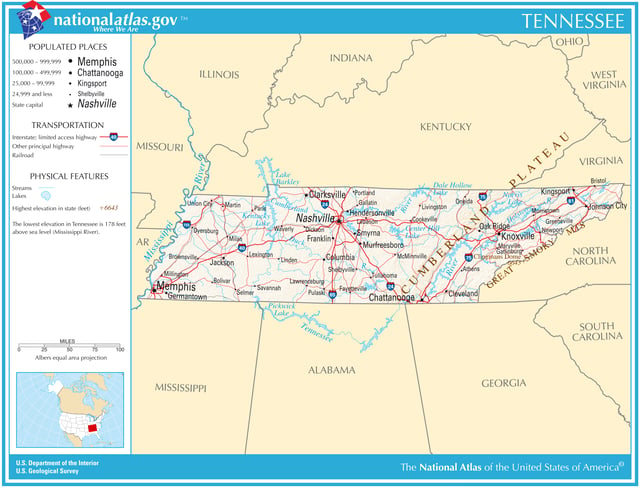
Map of Tennessee
Tennessee borders eight other states: Kentucky and Virginia to the north; North Carolina to the east; Georgia, Alabama, and Mississippi on the south; Arkansas and Missouri on the Mississippi River to the west. Tennessee is tied with Missouri as the state bordering the most other states. The state is trisected by the Tennessee River.
The highest point in the state is Clingmans Dome at 6,643 feet (2,025 m).[25] Clingmans Dome, which lies on Tennessee's eastern border, is the highest point on the Appalachian Trail, and is the third highest peak in the United States east of the Mississippi River. The state line between Tennessee and North Carolina crosses the summit. The state's lowest point is the Mississippi River at the Mississippi state line: 178 feet (54 m). The geographical center of the state is located in Murfreesboro.
The state of Tennessee is geographically, culturally, economically, and legally divided into three Grand Divisions: East Tennessee, Middle Tennessee, and West Tennessee. The state constitution allows no more than two justices of the five-member Tennessee Supreme Court to be from one Grand Division and a similar rule applies to certain commissions and boards.
Tennessee features six principal physiographic regions: the Blue Ridge, the Appalachian Ridge and Valley Region, the Cumberland Plateau, the Highland Rim, the Nashville Basin, and the Gulf Coastal Plain. Tennessee is home to the most caves in the United States, with over 10,000 documented caves to date.[26]
East Tennessee

Map of Tennessee highlighting East Tennessee
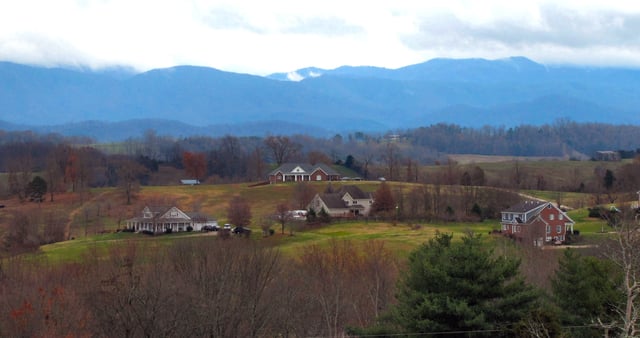
Bald Mountains
The Blue Ridge area lies on the eastern edge of Tennessee, which borders North Carolina.
This region of Tennessee is characterized by the high mountains and rugged terrain of the western Blue Ridge Mountains, which are subdivided into several subranges, namely the Great Smoky Mountains, the Bald Mountains, the Unicoi Mountains, the Unaka Mountains and Roan Highlands, and the Iron Mountains.
The average elevation of the Blue Ridge area is 5,000 feet (1,500 m) above sea level.
Clingmans Dome, the state's highest point, is located in this region. The Blue Ridge area was never more than sparsely populated, and today much of it is protected by the Cherokee National Forest, the Great Smoky Mountains National Park, and several federal wilderness areas and state parks.
Stretching west from the Blue Ridge for approximately 55 miles (89 km) is the Ridge and Valley region, in which numerous tributaries join to form the Tennessee River in the Tennessee Valley. This area of Tennessee is covered by fertile valleys separated by wooded ridges, such as Bays Mountain and Clinch Mountain. The western section of the Tennessee Valley, where the depressions become broader and the ridges become lower, is called the Great Valley. In this valley are numerous towns and two of the region's three urban areas, Knoxville, the third largest city in the state, and Chattanooga, the fourth largest city in the state. The third urban area, the Tri-Cities, comprising Bristol, Johnson City, and Kingsport and their environs, is located to the northeast of Knoxville.
The Cumberland Plateau rises to the west of the Tennessee Valley; this area is covered with flat-topped mountains separated by sharp valleys. The elevation of the Cumberland Plateau ranges from 1,500 to about 2,000 feet (460 to about 610 m) above sea level.
East Tennessee has several important transportation links with Middle and West Tennessee, as well as the rest of the nation and the world, including several major airports and interstates.
Knoxville's McGhee Tyson Airport (TYS) and Chattanooga's Chattanooga Metropolitan Airport (CHA), as well as the Tri-Cities' Tri-Cities Regional Airport (TRI), provide air service to numerous destinations. I-24, I-81, I-40, I-75, and I-26 along with numerous state highways and other important roads, traverse the Grand Division and connect Chattanooga, Knoxville, and the Tri-Cities, along with other cities and towns such as Cleveland, Athens, and Sevierville.
Middle Tennessee

Map of Tennessee highlighting Middle Tennessee
West of the Cumberland Plateau is the Highland Rim, an elevated plain that surrounds the Nashville Basin. The northern section of the Highland Rim, known for its high tobacco production, is sometimes called the Pennyroyal Plateau; it is located primarily in Southwestern Kentucky. The Nashville Basin is characterized by rich, fertile farm country and great diversity of natural wildlife.
Middle Tennessee was a common destination of settlers crossing the Appalachians from Virginia in the late 18th century and early 19th century.
An important trading route called the Natchez Trace, created and used for many generations by American Indians, connected Middle Tennessee to the lower Mississippi River town of Natchez. The route of the Natchez Trace was used as the basis for a scenic highway called the Natchez Trace Parkway.
Some of the last remaining large American chestnut trees grow in this region. They are being used to help breed blight-resistant trees.
Middle Tennessee is one of the primary state population and transportation centers along with the heart of state government.
Nashville (the capital), Clarksville, and Murfreesboro are its largest cities. Fifty percent of the US population is within 600 miles (970 km) of Nashville.[27] Interstates I-24, I-40, I-65, and I-840 service the Division, with the first three meeting in Nashville.
West Tennessee

Map of Tennessee highlighting West Tennessee
West of the Highland Rim and Nashville Basin is the Gulf Coastal Plain, which includes the Mississippi embayment. The Gulf Coastal Plain is, in terms of area, the predominant land region in Tennessee. It is part of the large geographic land area that begins at the Gulf of Mexico and extends north into southern Illinois. In Tennessee, the Gulf Coastal Plain is divided into three sections that extend from the Tennessee River in the east to the Mississippi River in the west.
The easternmost section, about 10 miles (16 km) in width, consists of hilly land that runs along the western bank of the Tennessee River.
To the west of this narrow strip of land is a wide area of rolling hills and streams that stretches all the way to the Mississippi River; this area is called the Tennessee Bottoms or bottom land.
In Memphis, the Tennessee Bottoms end in steep bluffs overlooking the river.
To the west of the Tennessee Bottoms is the Mississippi Alluvial Plain, less than 300 feet (91 m) above sea level. This area of lowlands, flood plains, and swamp land is sometimes referred to as the Delta region. Memphis is the economic center of West Tennessee.
Most of West Tennessee remained Indian land until the Chickasaw Cession of 1818, when the Chickasaw ceded their land between the Tennessee River and the Mississippi River. The portion of the Chickasaw Cession that lies in Kentucky is known today as the Jackson Purchase.
Public lands
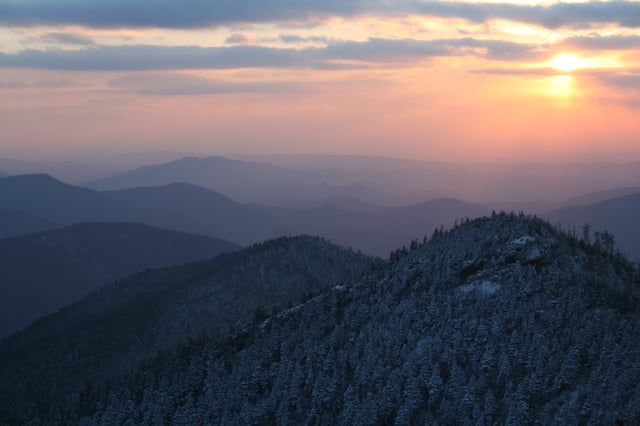
View from atop Mount Le Conte in the Great Smoky Mountains National Park, April 2007
Areas under the control and management of the National Park Service include the following:
Andrew Johnson National Historic Site in Greeneville
Appalachian National Scenic Trail
Big South Fork National River and Recreation Area
Chickamauga and Chattanooga National Military Park
Cumberland Gap National Historical Park
Foothills Parkway
Fort Donelson National Battlefield and Fort Donelson National Cemetery near Dover
Great Smoky Mountains National Park
Natchez Trace Parkway
Obed Wild and Scenic River near Wartburg
Overmountain Victory National Historic Trail
Shiloh National Cemetery and Shiloh National Military Park near Shiloh
Stones River National Battlefield and Stones River National Cemetery near Murfreesboro
Trail of Tears National Historic Trail
Fifty-four state parks, covering some 132,000 acres (530 km2) as well as parts of the Great Smoky Mountains National Park and Cherokee National Forest, and Cumberland Gap National Historical Park are in Tennessee. Sportsmen and visitors are attracted to Reelfoot Lake, originally formed by the 1811–12 New Madrid earthquakes; stumps and other remains of a once dense forest, together with the lotus bed covering the shallow waters, give the lake an eerie beauty.
Climate

A map of Köppen climate types in Tennessee
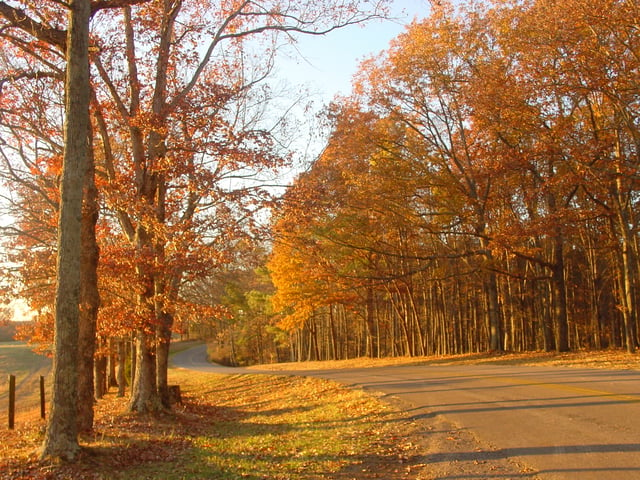
Autumn in Tennessee; roadway to Lindsey Lake in David Crockett State Park, located a half mile west of Lawrenceburg
Most of the state has a humid subtropical climate, with the exception of some of the higher elevations in the Appalachians, which are classified as having a mountain temperate or humid continental climate due to cooler temperatures.[28] The Gulf of Mexico is the dominant factor in the climate of Tennessee, with winds from the south being responsible for most of the state's annual precipitation. Generally, the state has hot summers and mild to cool winters with generous precipitation throughout the year, with highest average monthly precipitation generally in the winter and spring months, between December and April. The driest months, on average, are August to October. On average the state receives 50 inches (130 cm) of precipitation annually. Snowfall ranges from 5 inches (13 cm) in West Tennessee to over 80 inches (200 cm) in the highest mountains in East Tennessee.[29][30]
Summers in the state are generally hot and humid, with most of the state averaging a high of around 90 °F (32 °C) during the summer months.
Winters tend to be mild to cool, increasing in coolness at higher elevations.
Generally, for areas outside the highest mountains, the average overnight lows are near freezing for most of the state.
The highest recorded temperature is 113 °F (45 °C) at Perryville on August 9, 1930, while the lowest recorded temperature is −32 °F (−36 °C) at Mountain City on December 30, 1917.
While the state is far enough from the coast to avoid any direct impact from a hurricane, the location of the state makes it likely to be impacted from the remnants of tropical cyclones which weaken over land and can cause significant rainfall, such as Tropical Storm Chris in 1982 and Hurricane Opal in 1995.[31] The state averages around 50 days of thunderstorms per year, some of which can be severe with large hail and damaging winds. Tornadoes are possible throughout the state, with West and Middle Tennessee the most vulnerable. Occasionally, strong or violent tornadoes occur, such as the devastating April 2011 tornadoes that killed 20 people in North Georgia and Southeast Tennessee.[32] On average, the state has 15 tornadoes per year.[33] Tornadoes in Tennessee can be severe, and Tennessee leads the nation in the percentage of total tornadoes which have fatalities.[34] Winter storms are an occasional problem, such as the infamous Blizzard of 1993, although ice storms are a more likely occurrence. Fog is a persistent problem in parts of the state, especially in East Tennessee.
| Monthly Normal High and Low Temperatures For Various Tennessee Cities (F)[35] | ||||||||||||
| City | Jan | Feb | Mar | Apr | May | Jun | Jul | Aug | Sep | Oct | Nov | Dec |
|---|---|---|---|---|---|---|---|---|---|---|---|---|
| Bristol | 44/25 | 49/27 | 57/34 | 66/41 | 74/51 | 81/60 | 85/64 | 84/62 | 79/56 | 68/43 | 58/35 | 48/27 |
| Chattanooga | 49/30 | 54/33 | 63/40 | 72/47 | 79/56 | 86/65 | 90/69 | 89/68 | 82/62 | 72/48 | 61/40 | 52/33 |
| Knoxville | 47/30 | 52/33 | 61/40 | 71/48 | 78/57 | 85/65 | 88/69 | 87/68 | 81/62 | 71/50 | 60/41 | 50/34 |
| Memphis | 49/31 | 55/36 | 63/44 | 72/52 | 80/61 | 89/69 | 92/73 | 91/71 | 85/64 | 75/52 | 62/43 | 52/34 |
| Nashville | 46/28 | 52/31 | 61/39 | 70/47 | 78/57 | 85/65 | 90/70 | 89/69 | 82/61 | 71/49 | 59/40 | 49/32 |
Major cities
The capital and largest city is Nashville, though Knoxville, Kingston, and Murfreesboro have all served as state capitals in the past. Nashville's 13-county metropolitan area has been the state's largest since c. 1990. Memphis was the largest city in the state until being surpassed by Nashville in 2018. Chattanooga and Knoxville, both in the eastern part of the state near the Great Smoky Mountains, each has approximately one-third of the population of Memphis or Nashville. The city of Clarksville is a fifth significant population center, 45 miles (72 km) northwest of Nashville. Murfreesboro is the sixth-largest city in Tennessee, consisting of 136,372 residents.
History
Early history
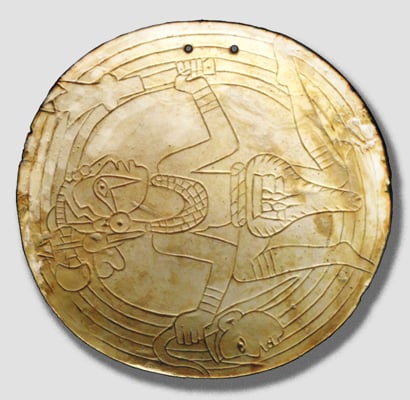
Mississippian-period shell gorget, Castalian Springs, Sumner County
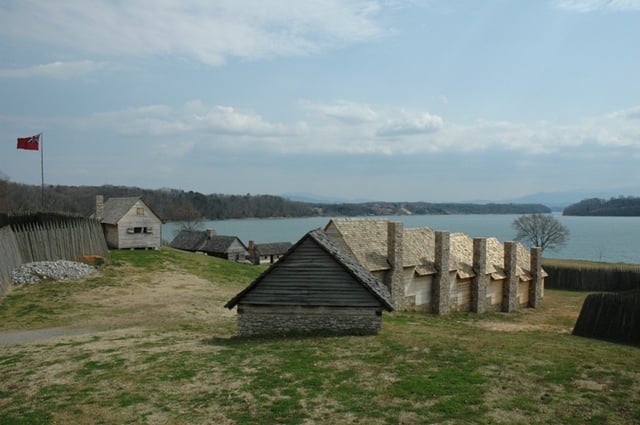
Reconstruction of Fort Loudon, the first British settlement in Tennessee
The area now known as Tennessee was first inhabited by Paleo-Indians nearly 12,000 years ago.[37] The names of the cultural groups that inhabited the area between first settlement and the time of European contact are unknown, but several distinct cultural phases have been named by archaeologists, including Archaic (8000–1000 BC), Woodland (1000 BC–1000 AD), and Mississippian (1000–1600 AD), whose chiefdoms were the cultural predecessors of the Muscogee people who inhabited the Tennessee River Valley before Cherokee migration into the river's headwaters.
The first recorded European excursions into what is now called Tennessee were three expeditions led by Spanish explorers, namely Hernando de Soto in 1540, Tristan de Luna in 1559, and Juan Pardo in 1567. Pardo recorded the name "Tanasqui" from a local Indian village, which evolved to the state's current name. At that time, Tennessee was inhabited by tribes of Muscogee and Yuchi people. Possibly because of European diseases devastating the Indian tribes, which would have left a population vacuum, and also from expanding European settlement in the north, the Cherokee moved south from the area now called Virginia. As European colonists spread into the area, the Indian populations were forcibly displaced to the south and west, including all Muscogee and Yuchi peoples, the Chickasaw and Choctaw, and ultimately, the Cherokee in 1838.
The first British settlement in what is now Tennessee was built in 1756 by settlers from the colony of South Carolina at Fort Loudoun, near present-day Vonore. Fort Loudoun became the westernmost British outpost to that date. The fort was designed by John William Gerard de Brahm and constructed by forces under British Captain Raymond Demeré. After its completion, Captain Raymond Demeré relinquished command on August 14, 1757, to his brother, Captain Paul Demeré. Hostilities erupted between the British and the neighboring Overhill Cherokees, and a siege of Fort Loudoun ended with its surrender on August 7, 1760. The following morning, Captain Paul Demeré and a number of his men were killed in an ambush nearby, and most of the rest of the garrison was taken prisoner.[38]
In the 1760s, long hunters from Virginia explored much of East and Middle Tennessee, and the first permanent European settlers began arriving late in the decade. The majority of 18th century settlers were English or of primarily English descent but nearly 20% of them were also Scotch-Irish.[39] These settlers formed the Watauga Association, a community built on lands leased from the Cherokee peoples.
During the American Revolutionary War, Fort Watauga at Sycamore Shoals (in present-day Elizabethton) was attacked (1776) by Dragging Canoe and his warring faction of Cherokee who were aligned with the British Loyalists. These renegade Cherokee were referred to by settlers as the Chickamauga. They opposed North Carolina's annexation of the Washington District and the concurrent settling of the Transylvania Colony further north and west. The lives of many settlers were spared from the initial warrior attacks through the warnings of Dragging Canoe's cousin, Nancy Ward. The frontier fort on the banks of the Watauga River later served as a 1780 staging area for the Overmountain Men in preparation to trek over the Appalachian Mountains, to engage, and to later defeat the British Army at the Battle of Kings Mountain in South Carolina.
Three counties of the Washington District (now part of Tennessee) broke off from North Carolina in 1784 and formed the State of Franklin. Efforts to obtain admission to the Union failed, and the counties (now numbering eight) had re-joined North Carolina by 1789. North Carolina ceded the area to the federal government in 1790, after which it was organized into the Southwest Territory. In an effort to encourage settlers to move west into the new territory, in 1787 the mother state of North Carolina ordered a road to be cut to take settlers into the Cumberland Settlements—from the south end of Clinch Mountain (in East Tennessee) to French Lick (Nashville). The Trace was called the "North Carolina Road" or "Avery's Trace", and sometimes "The Wilderness Road" (although it should not be confused with Daniel Boone's "Wilderness Road" through the Cumberland Gap).
Statehood (1796)
Tennessee was admitted to the Union on June 1, 1796 as the 16th state.
It was the first state created from territory under the jurisdiction of the United States federal government.
Apart from the former Thirteen Colonies only Vermont and Kentucky predate Tennessee's statehood, and neither was ever a federal territory.[40] The Constitution of the State of Tennessee, Article I, Section 31, states that the beginning point for identifying the boundary is the extreme height of the Stone Mountain, at the place where the line of Virginia intersects it, and basically runs the extreme heights of mountain chains through the Appalachian Mountains separating North Carolina from Tennessee past the Indian towns of Cowee and Old Chota, thence along the main ridge of the said mountain (Unicoi Mountain) to the southern boundary of the state; all the territory, lands and waters lying west of said line are included in the boundaries and limits of the newly formed state of Tennessee. Part of the provision also stated that the limits and jurisdiction of the state would include future land acquisition, referencing possible land trade with other states, or the acquisition of territory from west of the Mississippi River.
During the administration of U.S. President Martin Van Buren, nearly 17,000 Cherokees—along with approximately 2,000 black slaves owned by Cherokees—were uprooted from their homes between 1838 and 1839 and were forced by the U.S. military to march from "emigration depots" in Eastern Tennessee (such as Fort Cass) toward the more distant Indian Territory west of Arkansas (now the state of Oklahoma).[41]*Cherokee%20sunset%3A%20A%20n]]*uring this relocation an estimated 4,000 Cherokees died along the way west. Cherokee language]], the event is called te as a result of the Indian removal efforts of the United States, and so the phrase "Trail of Tears" is sometimes used to refer to similar events endured by other American Indian peoples, especially among the "Five Civilized Tribes". The phrase originated as a description of the earlier emigration of the Choctaw nation.
Civil War and Reconstruction

The Battle of Franklin, November 30, 1864
In February 1861, secessionists in Tennessee's state government—led by Governor Isham Harris—sought voter approval for a convention to sever ties with the United States, but Tennessee voters rejected the referendum by a 54–46% margin. The strongest opposition to secession came from East Tennessee (which later tried to form a separate Union-aligned state). Following the Confederate attack upon Fort Sumter in April and Lincoln's call for troops from Tennessee and other states in response, Governor Isham Harris began military mobilization, submitted an ordinance of secession to the General Assembly, and made direct overtures to the Confederate government. The Tennessee legislature ratified an agreement to enter a military league with the Confederate States on May 7, 1861. On June 8, 1861, with people in Middle Tennessee having significantly changed their position, voters approved a second referendum calling for secession, becoming the last state to do so.
Many major battles of the American Civil War were fought in Tennessee—most of them Union victories. Ulysses S. Grant and the U.S. Navy captured control of the Cumberland and Tennessee rivers in February 1862. They held off the Confederate counterattack at Shiloh in April. Memphis fell to the Union in June, following a naval battle on the Mississippi River in front of the city. The Capture of Memphis and Nashville gave the Union control of the western and middle sections. This control was confirmed at the Battle of Murfreesboro in early January 1863 and by the subsequent Tullahoma Campaign.
Despite the strength of Unionist sentiment in East Tennessee (with the exception of Sullivan County, which was heavily pro-Confederate), Confederates held the area. The Confederates, led by General James Longstreet, did attack General Burnside's Fort Sanders at Knoxville and lost. It was a big blow to East Tennessee Confederate momentum, but Longstreet won the Battle of Bean's Station a few weeks later. The Confederates besieged Chattanooga during the Chattanooga Campaign in early fall 1863, but were driven off by Grant in November. Many of the Confederate defeats can be attributed to the poor strategic vision of General Braxton Bragg, who led the Army of Tennessee from Perryville, Kentucky to another Confederate defeat at Chattanooga.
The last major battles came when the Confederates invaded Middle Tennessee in November 1864 and were checked at Franklin, then completely dispersed by George Thomas at Nashville in December. Meanwhile, the civilian Andrew Johnson was appointed military governor of the state by President Abraham Lincoln.
When the Emancipation Proclamation was announced, Tennessee was largely held by Union forces. Thus, Tennessee was not among the states enumerated in the Proclamation, and the Proclamation did not free any slaves there. Nonetheless, enslaved African Americans escaped to Union lines to gain freedom without waiting for official action. Old and young, men, women and children camped near Union troops. Thousands of former slaves ended up fighting on the Union side, nearly 200,000 in total across the South.
Tennessee's legislature approved an amendment to the state constitution prohibiting slavery on February 22, 1865.[43] Voters in the state approved the amendment in March.[44] It also ratified the Thirteenth Amendment to the United States Constitution (abolishing slavery in every state) on April 7, 1865.
In 1864, Andrew Johnson (a War Democrat from Tennessee) was elected Vice President under Abraham Lincoln. He became President after Lincoln's assassination in 1865. Under Johnson's lenient re-admission policy, Tennessee was the first of the seceding states to have its elected members readmitted to the U.S. Congress, on July 24, 1866. Because Tennessee had ratified the Fourteenth Amendment, it was the only one of the formerly secessionist states that did not have a military governor during the Reconstruction period.
After the formal end of Reconstruction, the struggle over power in Southern society continued.
Through violence and intimidation against freedmen and their allies, White Democrats regained political power in Tennessee and other states across the South in the late 1870s and 1880s.
Over the next decade, the state legislature passed increasingly restrictive laws to control African Americans.
In 1889 the General Assembly passed four laws described as electoral reform, with the cumulative effect of essentially disfranchising most African Americans in rural areas and small towns, as well as many poor Whites.
Legislation included implementation of a poll tax, timing of registration, and recording requirements.
Tens of thousands of taxpaying citizens were without representation for decades into the 20th century.[13] Disfranchising legislation accompanied Jim Crow laws passed in the late 19th century, which imposed segregation in the state. In 1900, African Americans made up nearly 24% of the state's population, and numbered 480,430 citizens who lived mostly in the central and western parts of the state.[45]
In 1897, Tennessee celebrated its centennial of statehood (though one year late of the 1896 anniversary) with a great exposition in Nashville. A full-scale replica of the Parthenon was constructed for the celebration, located in what is now Nashville's Centennial Park.
20th century

A group of workers at Norris Dam construction camp site. The TVA was formed as part of Roosevelt's New Deal legislation.
On August 18, 1920, Tennessee became the thirty-sixth and final state necessary to ratify the Nineteenth Amendment to the United States Constitution, which provided women the right to vote. Disfranchising voter registration requirements continued to keep most African Americans and many poor whites, both men and women, off the voter rolls.
The need to create work for the unemployed during the Great Depression, a desire for rural electrification, the need to control annual spring flooding and improve shipping capacity on the Tennessee River were all factors that drove the federal creation of the Tennessee Valley Authority (TVA) in 1933. Through the power of the TVA projects, Tennessee quickly became the nation's largest public utility supplier.
During World War II, the availability of abundant TVA electrical power led the Manhattan Project to locate one of the principal sites for production and isolation of weapons-grade fissile material in East Tennessee. The planned community of Oak Ridge was built from scratch to provide accommodations for the facilities and workers. These sites are now Oak Ridge National Laboratory, the Y-12 National Security Complex, and the East Tennessee Technology Park.
Despite recognized effects of limiting voting by poor whites, successive legislatures expanded the reach of the disfranchising laws until they covered the state.
Political scientist V. O. Key, Jr. argued in 1949 that:
...the size of the poll tax did not inhibit voting as much as the inconvenience of paying it. County officers regulated the vote by providing opportunities to pay the tax (as they did in Knoxville), or conversely by making payment as difficult as possible. Such manipulation of the tax, and therefore the vote, created an opportunity for the rise of urban bosses and political machines. Urban politicians bought large blocks of poll tax receipts and distributed them to blacks and whites, who then voted as instructed.[13]
In 1953 state legislators amended the state constitution, removing the poll tax.
In many areas both blacks and poor whites still faced subjectively applied barriers to voter registration that did not end until after passage of national civil rights legislation, including the Voting Rights Act of 1965.[13]
Tennessee celebrated its bicentennial in 1996.
With a yearlong statewide celebration entitled "Tennessee 200", it opened a new state park (Bicentennial Mall) at the foot of Capitol Hill in Nashville.
21st century
In 2002, businessman Phil Bredesen was elected to become the 48th governor in January 2003. Also in 2002, Tennessee amended the state constitution to allow for the establishment of a lottery. Tennessee's Bob Corker was the only freshman Republican elected to the United States Senate in the 2006 midterm elections. The state constitution was amended to reject same-sex marriage. In January 2007, Ron Ramsey became the first Republican elected as Speaker of the State Senate since Reconstruction, as a result of the realignment of the Democratic and Republican parties in the South since the late 20th century, with Republicans now elected by conservative voters, who previously had supported Democrats.
In 2010, during the 2010 midterm elections, Bill Haslam was elected to succeed Bredesen, who was term-limited, to become the 49th Governor of Tennessee in January 2011. In April and May 2010, flooding in Middle Tennessee devastated Nashville and other parts of Middle Tennessee. In 2011, parts of East Tennessee, including Hamilton County and Apison in Bradley County, were devastated by the April 2011 tornado outbreak.
Demographics

Tennessee population density map, 2010
| Historical population | |||
|---|---|---|---|
| Census | Pop. | %± | |
| 35,691 | — | ||
| 1800 | 105,602 | 195.9% | |
| 261,727 | 147.8% | ||
| 1820 | 422,823 | 61.6% | |
| 681,904 | 61.3% | ||
| 1840 | 829,210 | 21.6% | |
| 1,002,717 | 20.9% | ||
| 1860 | 1,109,801 | 10.7% | |
| 1,258,520 | 13.4% | ||
| 1880 | 1,542,359 | 22.6% | |
| 1,767,518 | 14.6% | ||
| 1900 | 2,020,616 | 14.3% | |
| 2,184,789 | 8.1% | ||
| 1920 | 2,337,885 | 7.0% | |
| 2,616,556 | 11.9% | ||
| 1940 | 2,915,841 | 11.4% | |
| 3,291,718 | 12.9% | ||
| 1960 | 3,567,089 | 8.4% | |
| 3,923,687 | 10.0% | ||
| 1980 | 4,591,120 | 17.0% | |
| 4,877,185 | 6.2% | ||
| 2000 | 5,689,283 | 16.7% | |
| 6,346,105 | 11.5% | ||
| Est. 2019 | 6,895,418 | 8.7% | |
| Source: 1910–2010[48]2018 estimate[49] | |||
The United States Census Bureau estimates that the population of Tennessee was 6,770,010 on July 1, 2018, an increase of 423,905 people since the 2010 United States Census, or 6.68%.[49] This includes a natural increase since the last census of 124,385 people (that is 584,236 births minus 459,851 deaths), and an increase from net migration of 244,537 people into the state. Immigration from outside the United States resulted in a net increase of 66,412 people, and migration within the country produced a net increase of 178,125 people.[50]
Twenty percent of Tennesseans were born outside the South in 2008, compared to a figure of 13.5% in 1990.[51] In recent years, Tennessee has received an influx of people relocating from California, Florida, New York, Massachusetts, New Jersey, the New England States and several northern states for the low cost of living, and the booming healthcare and automobile industries. Metropolitan Nashville is one of the fastest-growing areas in the country due in part to these factors.
The center of population of Tennessee is located in Rutherford County, in the city of Murfreesboro.[52]
As of the 2010 census, the racial composition of Tennessee's population was as follows:
| Racial composition | 1990[53] | 2000[54] | 2010[54] | 2013 est. |
|---|---|---|---|---|
| White | 83.0% | 80.2% | 77.6% | 79.1% |
| Black | 16.0% | 16.4% | 16.7% | 17.0% |
| Asian | 0.7% | 1.0% | 1.4% | 1.6% |
| Native | 0.2% | 0.3% | 0.3% | 0.4% |
| Native Hawaiianand other Pacific Islander | – | – | 0.1% | 0.1% |
| Other race | 0.2% | 1.0% | 2.2% | – |
| Two or more races | – | 1.1% | 1.7% | 1.7% |
In 2000, the five most common self-reported ethnic groups in the state were: American (17.3%), African American (13.0%), Irish (9.3%), English (9.1%), and German (8.3%).[56] Most Tennesseans who self-identify as having American ancestry are of English and Scotch-Irish ancestry. An estimated 21–24% of Tennesseans are of predominantly English ancestry.[57][58] In the 1980 census 1,435,147 Tennesseans claimed "English" or "mostly English" ancestry out of a state population of 3,221,354 making them 45% of the state at the time.[59]
According to the 2010 census, 6.4% of Tennessee's population were reported as under 5 years of age, 23.6% under 18, and 13.4% were 65 or older.
Females made up approximately 51.3% of the population.[60]
On June 19, 2010, the Tennessee Commission of Indian Affairs granted state recognition to six Indian tribes which was later repealed by the state's Attorney General because the action by the commission was illegal. The tribes were as follows:
The Cherokee Wolf Clan in western Tennessee, with members in Carroll County, Benton, Decatur, Henderson, Henry, Weakley, Gibson and Madison counties.
The Chikamaka Band, based historically on the South Cumberland Plateau, said to have members in Franklin, Grundy, Marion, Sequatchie, Warren and Coffee counties.
Central Band of Cherokee, also known as the Cherokee of Lawrence County, Tennessee.
United Eastern Lenapee Nation of Winfield, Tennessee.
The Tanasi Council, said to have members in Shelby, Dyer, Gibson, Humphreys and Perry counties; and
Remnant Yuchi Nation, with members in Sullivan, Carter, Greene, Hawkins, Unicoi, Johnson and Washington counties.[61]
Birth data
As of 2011, 36.3% of Tennessee's population younger than age 1 were minorities.[62]
Note: Births in table do not add up, because Hispanics are counted both by their ethnicity and by their race, giving a higher overall number.
| Race | 2013[63] | 2014[64] | 2015[65] | 2016[66] | 2017[67] |
|---|---|---|---|---|---|
| White: | 59,804 (74.7%) | 61,391 (75.2%) | 61,814 (75.7%) | ... | ... |
Non-Hispanic White | 54,377 (68.0%) | 55,499 (68.0%) | 55,420 (67.8%) | 53,866 (66.7%) | 53,721 (66.3%) |
| Black | 17,860 (22.3%) | 17,791 (21.8%) | 17,507 (21.4%) | 15,889 (19.7%) | 16,050 (19.8%) |
| Asian | 2,097 (2.6%) | 2,180 (2.7%) | 2,153 (2.6%) | 1,875 (2.3%) | 1,905 (2.4%) |
| American Indian | 231 (0.3%) | 240 (0.3%) | 211 (0.2%) | 77 (0.1%) | 150 (0.2%) |
| Hispanic | 6,854(8.6%) | 6,986(8.6%) | 7,264(8.9%) | 7,631(9.4%) | 7,684(9.5%) |
| Total Tennessee | 79,992(100%) | 81,602(100%) | 81,685(100%) | 80,807(100%) | 81,016(100%) |
Since 2016, data for births of White Hispanic origin are not collected, but included in one Hispanic group; persons of Hispanic origin may be of any race.
Religion
The religious affiliations of the people of Tennessee as of 2014:[68]
Christian: 81% Protestant: 73% Evangelical Protestant: 52% Mainline Protestant: 13% Historically Black Protestant: 8% Roman Catholic: 6% Mormon: 1% Orthodox Christian: <1% Other Christian (includes unspecified "Christian" and "Protestant"): <1%
Islam: 1%
Jewish: 1%
Other religions: 3%
Non-religious: 14% Atheist: 1% Agnostic: 3% Nothing in particular: 11%
The largest denominations by number of adherents in 2010 were the Southern Baptist Convention with 1,483,356; the United Methodist Church with 375,693; the Roman Catholic Church with 222,343; and the Churches of Christ with 214,118.[69]
As of January 1, 2009, The Church of Jesus Christ of Latter-day Saints (LDS Church) reported 43,179 members, 10 stakes, 92 Congregations (68 wards and 24 branches), two missions, and two temples in Tennessee.[70]
Tennessee is home to several Protestant denominations, such as the National Baptist Convention (headquartered in Nashville); the Church of God in Christ and the Cumberland Presbyterian Church (both headquartered in Memphis); the Church of God and The Church of God of Prophecy (both headquartered in Cleveland). The Free Will Baptist denomination is headquartered in Antioch; its main Bible college is in Nashville. The Southern Baptist Convention maintains its general headquarters in Nashville. Publishing houses of several denominations are located in Nashville.
Economy

A geomap showing the counties of Tennessee colored by the relative range of that county's median income.

Chart showing percentage of the population of Tennessee (divided by age and gender) living below the poverty line as of 2015.
According to the U.S.
Bureau of Economic Analysis, in 2011 Tennessee's real gross state product was $233.997 billion.
In 2003, the per capita personal income was $28,641, 36th in the nation, and 91% of the national per capita personal income of $31,472. In 2004, the median household income was $38,550, 41st in the nation, and 87% of the national median of $44,472.
For 2012, the state held an asset surplus of $533 million, one of only eight states in the nation to report a surplus.[71]
Major outputs for the state include textiles, cotton, cattle, and electrical power.
Tennessee has over 82,000 farms, roughly 59 percent of which accommodate beef cattle.[72] Although cotton was an early crop in Tennessee, large-scale cultivation of the fiber did not begin until the 1820s with the opening of the land between the Tennessee and Mississippi Rivers.
The upper wedge of the Mississippi Delta extends into southwestern Tennessee, and it was in this fertile section that cotton took hold.
Soybeans are also heavily planted in West Tennessee, focusing on the northwest corner of the state.[73]
Large corporations with headquarters in Tennessee include FedEx, AutoZone and International Paper, all based in Memphis; Pilot Corporation and Regal Entertainment Group, based in Knoxville; Eastman Chemical Company, based in Kingsport; Hospital Corporation of America and Caterpillar Financial, based in Nashville; and Unum, based in Chattanooga. Tennessee is also the location of the Volkswagen assembly plant in Chattanooga, a $2 billion polysilicon production facility by Wacker Chemie in Bradley County, and a $1.2 billion polysilicon production facility by Hemlock Semiconductor in Clarksville.
Tennessee is also a major hub for the automotive industry.[74] Three automobile manufacturers have factories in Tennessee: Nissan in Smyrna, General Motors in Spring Hill, and Volkswagen in Chattanooga.[75] Nissan moved its North American corporate headquarters from California to Franklin, Tennessee in 2005,[76] and Mitsubishi Motors did the same in 2019.[74]
Tennessee is a right to work state, as are most of its Southern neighbors. Unionization has historically been low and continues to decline as in most of the U.S. generally. As of August 2019, the state has an unemployment rate of 3.5%, which is ranked 28th in the country.[77] As of 2015, 16.7% of the population of Tennessee lives below the poverty line, which is higher than the national average of 14.7%.[78]
Tax
Tennessee's Hall income tax does not apply to salaries and wages, but most dividends and interest are taxable. The tax rate was 6% from 1937 to 2016, but is 3% for the 2018 tax year and is set to ramp down to zero in 2021. The first $1,250 of individual income and $2,500 of joint income is exempt from this tax.
The state's sales and use tax rate for most items is 7%. Food is taxed at a lower rate of 5.25%, but candy, dietary supplements and prepared food are taxed at the full 7% rate. Local sales taxes are collected in most jurisdictions, at rates varying from 1.5% to 2.75%, bringing the total sales tax to between 8.5% and 9.75%, one of the highest levels in the nation.
Intangible property tax is assessed on the shares of stock of stockholders of any loan company, investment company, insurance company or for-profit cemetery companies. The assessment ratio is 40% of the value multiplied by the tax rate for the jurisdiction.
Tennessee imposes an inheritance tax on decedents' estates that exceed maximum single exemption limits ($1,000,000 for deaths in 2006 and thereafter).[79]
Tourism
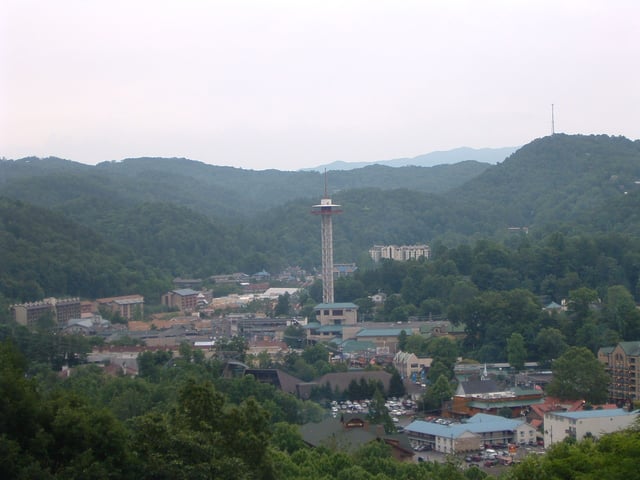
Gatlinburg is a popular tourist destination bordering the Great Smoky Mountains.
Tourism contributes billions of dollars every year to the state's economy and Tennessee is ranked among the Top 10 destinations in the US.[80] In 2014 a record 100 million people visited the state resulting in $17.7 billion in tourism related spending within the state, an increase of 6.3% over 2013; tax revenue from tourism equaled $1.5 billion.
Each county in Tennessee saw at least $1 million from tourism while 19 counties received at least $100 million (Davidson, Shelby, and Sevier counties were the top three).
Tourism-generated jobs for the state reached 152,900, a 2.8% increase.[80] International travelers to Tennessee accounted for $533 million in spending.[81]
In 2013 tourism within the state from local citizens accounted for 39.9% of tourists, the second highest originating location for tourists to Tennessee is the state of Georgia, accounting for 8.4% of tourists.[82] Forty-four percent of stays in the state were "day trips", 25% stayed one night, 15% stayed two nights, and 11% stayed 4 or more nights.
The average stay was 2.16 nights, compared to 2.03 nights for the US as a whole.[82] The average person spent $118 per day: 29% on transportation, 24% on food, 17% on accommodation, and 28% on shopping and entertainment.[82]
Some of the top tourist attractions in the state are:[83] the Great Smoky Mountains National Park, Graceland, Dollywood, Beale Street, Pigeon Forge, Lower Broadway, the Ryman Auditorium, Gaylord Opryland Resort, Lookout Mountain, the Ocoee River, and the Tennessee Aquarium.
Culture
Music
Tennessee has played a critical role in the development of many forms of American popular music, including rock and roll, blues, country, and rockabilly. Beale Street in Memphis is considered by many to be the birthplace of the blues, with musicians such as W. C. Handy performing in its clubs as early as 1909.[84] Memphis is also home to Sun Records, where musicians such as Elvis Presley, Johnny Cash, Carl Perkins, Jerry Lee Lewis, Roy Orbison, and Charlie Rich began their recording careers, and where rock and roll took shape in the 1950s.[85] The 1927 Victor recording sessions in Bristol generally mark the beginning of the country music genre and the rise of the Grand Ole Opry in the 1930s helped make Nashville the center of the country music recording industry.[86][87] Three brick-and-mortar museums recognize Tennessee's role in nurturing various forms of popular music: the Memphis Rock N' Soul Museum, the Country Music Hall of Fame and Museum in Nashville, and the International Rock-A-Billy Museum in Jackson. Moreover, the Rockabilly Hall of Fame, an online site recognizing the development of rockabilly in which Tennessee played a crucial role, is based in Nashville.
Literature
Sports

Tennessee Titans

Memphis Grizzlies

Nashville Predators

Memphis Redbirds

Nashville Sounds

Tennessee Volunteers football
Tennessee is home to three major professional sports franchises: the Tennessee Titans have played in the National Football League since 1997, the Memphis Grizzlies have played in the National Basketball Association since 2001, and the Nashville Predators have played in the National Hockey League since 1998. A Major League Soccer franchise, Nashville SC, is scheduled to begin play in Nashville in 2020.[88]
The state is also home to 14 teams playing in minor leagues.
Nine Minor League Baseball teams call the state their home. The Memphis Redbirds and Nashville Sounds, each of the Pacific Coast League, compete at the Triple-A level, the highest before Major League Baseball. The Chattanooga Lookouts, Jackson Generals, and Tennessee Smokies play in the Double-A Southern League. The Elizabethton Twins, Greeneville Reds, Johnson City Cardinals, and Kingsport Mets are Rookie League teams of the Appalachian League.
The Knoxville Ice Bears are a minor league ice hockey team of the Southern Professional Hockey League. The current version of Nashville SC plays in the USL Championship (USLC), the second level of U.S. soccer, through the 2019 season, after which the team will cease minor-league operations and its name will be taken up by the new MLS team. Two new Tennessee teams began play in leagues operated by the United Soccer League in 2019. Memphis 901 FC joined the USLC,[89] and Chattanooga Red Wolves SC became an inaugural member of the new third-level USL League One. Three soccer teams compete in the National Premier Soccer League, one of a number of de facto fourth-level leagues in the U.S. The Knoxville Force and Memphis City FC play in the main NPSL, while Chattanooga FC plays in the 2019 NPSL Founders Cup, a competition intended to create a fully professional league within the NPSL structure.
In Knoxville, the Tennessee Volunteers college team has played in the Southeastern Conference (SEC) of the National Collegiate Athletic Association since the conference was formed in 1932. The football team has won 13 SEC championships and 28 bowls, including four Sugar Bowls, three Cotton Bowls, an Orange Bowl and a Fiesta Bowl. Meanwhile, the men's basketball team has won four SEC championships and reached the NCAA Elite Eight in 2010. In addition, the women's basketball team has won a host of SEC regular-season and tournament titles along with eight national titles.
In Nashville, the Vanderbilt Commodores are also charter members of the SEC. The Tennessee–Vanderbilt football rivalry began in 1892, having since played over 100 times. In June 2014, the Vanderbilt Commodores baseball team won its first men's national championship by winning the 2014 College World Series.
The state is home to 10 other NCAA Division I programs. Two of these participate in the top level of college football, the Football Bowl Subdivision. The Memphis Tigers are members of the American Athletic Conference, and the Middle Tennessee Blue Raiders from Murfreesboro play in Conference USA. In addition to the Commodores, Nashville is also home to the Belmont Bruins and Tennessee State Tigers, both members of the Ohio Valley Conference (OVC), and the Lipscomb Bisons, members of the Atlantic Sun Conference. Tennessee State plays football in Division I's second level, the Football Championship Subdivision (FCS), while Belmont and Lipscomb do not have football teams. Belmont and Lipscomb have an intense rivalry in men's and women's basketball known as the Battle of the Boulevard, with both schools' men's and women's teams playing two games each season against each other (a rare feature among non-conference rivalries). The OVC also includes the Austin Peay Governors from Clarksville, the UT Martin Skyhawks from Martin, and the Tennessee Tech Golden Eagles from Cookeville. These three schools, along with fellow OVC member Tennessee State, play each season in football for the Sgt. York Trophy. The Chattanooga Mocs and Johnson City's East Tennessee State Buccaneers are full members, including football, of the Southern Conference.
Tennessee is also home to Bristol Motor Speedway which features NASCAR Cup Series racing two weekends a year, routinely selling out more than 160,000 seats on each date; it also was the home of the Nashville Superspeedway, which held Nationwide and IndyCar races until it was shut down in 2012. Tennessee's only graded stakes horse race, the Iroquois Steeplechase, is also held in Nashville each May.
The FedEx St. Jude Classic is a PGA Tour golf tournament held at Memphis since 1958. The U.S. National Indoor Tennis Championships has been held at Memphis since 1976 (men's) and 2002 (women's).
Sports teams
| Club | Sport | League |
|---|---|---|
| Tennessee Titans | American football | National Football League |
| Memphis Express | American football | Alliance of American Football |
| Memphis Grizzlies | Basketball | National Basketball Association |
| Nashville Predators | Ice hockey | National Hockey League |
| Nashville SC(from 2020) | Soccer | Major League Soccer |
| Memphis Redbirds | Baseball | Pacific Coast League(Triple-A) |
| Nashville Sounds | Baseball | Pacific Coast League(Triple-A) |
| Chattanooga Lookouts | Baseball | Southern League(Double-A) |
| Jackson Generals | Baseball | Southern League(Double-A) |
| Tennessee Smokies | Baseball | Southern League(Double-A) |
| Elizabethton Twins | Baseball | Appalachian League(Rookie) |
| Greeneville Reds | Baseball | Appalachian League(Rookie) |
| Johnson City Cardinals | Baseball | Appalachian League(Rookie) |
| Kingsport Mets | Baseball | Appalachian League(Rookie) |
| Knoxville Ice Bears | Ice hockey | Southern Professional Hockey League |
| Memphis 901 FC | Soccer | USL Championship |
| Nashville SC(through 2019) | Soccer | USL Championship |
| Chattanooga Red Wolves SC | Soccer | USL League One |
| Chattanooga FC | Soccer | NPSL Founders Cup |
| Knoxville Force | Soccer | National Premier Soccer League |
| Memphis City FC | Soccer | National Premier Soccer League |
Transportation
Interstate highways

The Hernando de Soto Bridge spans the Mississippi River in Memphis
Interstate 40 crosses the state in a west-east orientation. Its branch interstate highways include I-240 in Memphis; I-440 in Nashville; I-840 in Nashville; I-140 from Knoxville to Alcoa; and I-640 in Knoxville. I-26, although technically an east-west interstate, runs from the North Carolina border below Johnson City to its terminus at Kingsport. I-24 is an east-west interstate that runs cross-state from Chattanooga to Clarksville. In a north-south orientation are highways I-55, I-65, I-75, and I-81. Interstate 65 crosses the state through Nashville, while Interstate 75 serves Chattanooga and Knoxville and Interstate 55 serves Memphis. Interstate 81 enters the state at Bristol and terminates at its junction with I-40 near Dandridge. I-155 is a branch highway from I-55. The only spur highway of I-75 in Tennessee is I-275, which is in Knoxville. When completed, I-69 will travel through the western part of the state, from South Fulton to Memphis. A branch interstate, I-269 also exists from Millington to Collierville.
Airports
Major airports within the state include Memphis International Airport (MEM), Nashville International Airport (BNA), McGhee Tyson Airport (TYS) outside of Knoxville in Blount County, Chattanooga Metropolitan Airport (CHA), Tri-Cities Regional Airport (TRI), and McKellar-Sipes Regional Airport (MKL), in Jackson. Because Memphis International Airport is the major hub for FedEx Corporation, it is the world's largest air cargo operation.
Railroads
For passenger rail service, Memphis and Newbern, are served by the Amtrak City of New Orleans line on its run between Chicago, Illinois, and New Orleans, Louisiana. Nashville is served by the Music City Star commuter rail service.
Cargo services in Tennessee are primarily served by CSX Transportation, which has a hump yard in Nashville called Radnor Yard. Norfolk Southern Railway operates lines in East Tennessee, through cities including Knoxville and Chattanooga, and operates a classification yard near Knoxville, the John Sevier Yard. BNSF operates a major intermodal facility in Memphis.
Governance
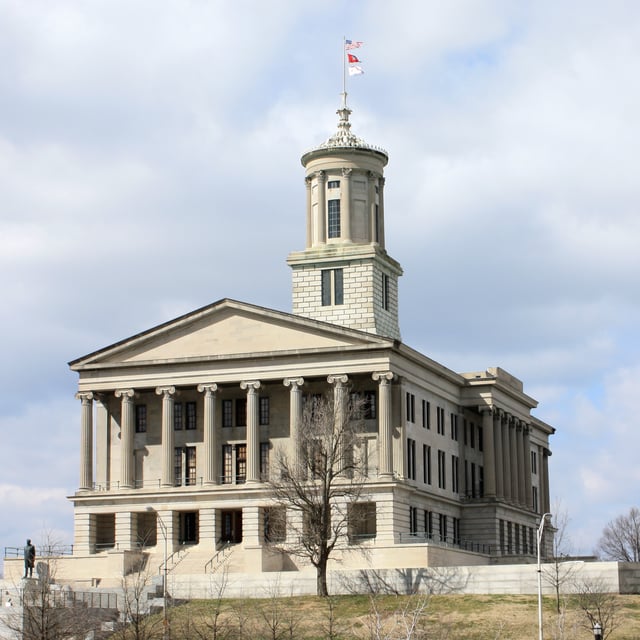
Tennessee State Capitol in Nashville
Similar to the United States Federal Government, Tennessee's government has three parts.
The Executive Branch is led by Tennessee's governor, who holds office for a four-year term and may serve a maximum of two consecutive terms.
The governor is the only official who is elected statewide.
Unlike most states, the state does not elect the lieutenant governor directly; the Tennessee Senate elects its Speaker, who serves as lieutenant governor. The governor is supported by 22 cabinet-level departments, most headed by a commissioner who serves at the pleasure of the governor:
Department of Agriculture
Department of Children's Services
Department of Commerce and Insurance
Department of Correction
Department of Economic & Community Development
Department of Education
Department of Environment and Conservation
Department of Finance & Administration
Department of Financial Institutions
Department of General Services
Department of Health
Department of Human Resources
Department of Human Services
Department of Intellectual and Developmental Disabilities
Department of Labor and Workforce Development
Department of Mental Health and Substance Abuse Services
Department of Military
Department of Revenue
Department of Safety and Homeland Security
Department of Tourist Development
Department of Transportation
Department of Veterans Services
The Executive Branch also includes several agencies, boards and commissions, some of which are under the auspices of one of the cabinet-level departments.[90]
The bicameral Legislative Branch, known as the Tennessee General Assembly, consists of the 33-member Senate and the 99-member House of Representatives. Senators serve four-year terms, and House members serve two-year terms. Each chamber chooses its own speaker. The speaker of the state Senate also holds the title of lieutenant-governor. Constitutional officials in the legislative branch are elected by a joint session of the legislature.
The highest court in Tennessee is the state Supreme Court. It has a chief justice and four associate justices. No more than two justices can be from the same Grand Division. The Supreme Court of Tennessee also appoints the Attorney General, a practice that is not found in any of the other 49 states. Both the Court of Appeals and the Court of Criminal Appeals have 12 judges.[91] A number of local, circuit, and federal courts provide judicial services.
Tennessee's current state constitution was adopted in 1870. The state had two earlier constitutions. The first was adopted in 1796, the year Tennessee joined the union, and the second was adopted in 1834. The 1870 Constitution outlaws martial law within its jurisdiction. This may be a result of the experience of Tennessee residents and other Southerners during the period of military control by Union (Northern) forces of the U.S. government after the American Civil War.
Politics
| Year | Republican | Democratic |
|---|---|---|
| 2016 | 60.72%1,522,925 | 34.72%870,695 |
| 2012 | 59.42%1,462,330 | 39.04%960,709 |
| 2008 | 56.85%1,479,178 | 41.79%1,087,437 |
| 2004 | 56.80%1,384,375 | 42.53%1,036,477 |
| 2000 | 51.15%1,061,949 | 47.28%981,720 |
| 1996 | 45.59%863,530 | 48.00%909,146 |
| 1992 | 42.43%841,300 | 47.08%933,521 |
| 1988 | 57.89%947,233 | 41.55%679,794 |
| 1984 | 57.84%990,212 | 41.57%711,714 |
| 1980 | 48.70%787,761 | 48.41%783,051 |
| 1976 | 42.94%633,969 | 55.94%825,879 |
| 1972 | 67.70%813,147 | 29.75%357,293 |
| 1968 | 37.85%472,592 | 28.13%351,233 |
| 1964 | 44.49%508,965 | 55.50%634,947 |
| 1960 | 52.92%556,577 | 45.77%481,453 |
Tennessee politics, like that of most U.S. states, are dominated by the Republican and the Democratic parties. Historian Dewey W. Grantham traces divisions in the state to the period of the American Civil War: for decades afterward, the eastern third of the state was Republican and the western two thirds voted Democrat.[92] This division was related to the state's pattern of farming, plantations and slaveholding. The eastern section was made up of yeoman farmers, but Middle and West Tennessee farmers cultivated crops such as tobacco and cotton which were dependent on the use of slave labor. These areas became defined as Democratic after the war.
During Reconstruction, freedmen and former free people of color were granted the right to vote; most joined the Republican Party.
Numerous African Americans were elected to local offices, and some to state office.
Following Reconstruction, Tennessee continued to have competitive party politics; but in the 1880s, the white-dominated state government passed four laws, the last of which imposed a poll tax requirement for voter registration.
These served to disenfranchise most African Americans, and their power in state and local politics was markedly reduced. In 1900 African Americans comprised 23.8 percent of the state's population, concentrated in Middle and West Tennessee.[45] In the early 1900s, the state legislature approved a form of commission government for cities based on at-large voting for a few positions on a Board of Commission; several cities adopted this as another means to limit African-American political participation. In 1913 the state legislature enacted a bill enabling cities to adopt this structure without legislative approval.[93]
After disenfranchisement of blacks, the Republican Party in Tennessee became a primarily white sectional party supported only in the eastern part of the state. In the 20th century, except for two nationwide Republican landslides of the 1920s (in 1920, when Tennessee narrowly supported Warren G. Harding over Ohio Governor James Cox, and in 1928, when it more decisively voted for Herbert Hoover over New York Governor Al Smith), the state was part of the Democratic Solid South until the 1950s. In that postwar decade, it twice voted for Republican Dwight D. Eisenhower, former Allied Commander of the Armed Forces during World War II. Since then, more of the state's voters have shifted to supporting Republicans, and Democratic presidential candidates have carried Tennessee only four times.
By 1960 African Americans comprised 16.45% of the state's population.
It was not until after the mid-1960s and passage of the Voting Rights Act of 1965 that they were able to vote in full again, but new devices, such as at-large commission city governments, had been adopted in several jurisdictions to limit their political participation. Former Gov. Winfield Dunn and former U.S. Sen. Bill Brock wins in 1970 helped make the Republican Party competitive among whites for the statewide victory. Tennessee has selected governors from different parties since 1970.
In the early 21st century, Republican voters control most of the state, especially in the more rural and suburban areas outside of the cities; Democratic strength is mostly confined to the urban cores of the four major cities, and is particularly strong in the cities of Nashville and Memphis.
The latter area includes a large African-American population.[94] Historically, Republicans had their greatest strength in East Tennessee before the 1960s. Tennessee's 1st and 2nd congressional districts, based in the Tri-Cities and Knoxville, respectively, are among the few historically Republican districts in the South. Those districts' residents supported the Union over the Confederacy during the Civil War; they identified with the GOP after the war and have stayed with that party ever since. The first has been in Republican hands continuously since 1881, and Republicans (or their antecedents) have held it for all but four years since 1859. The second has been held continuously by Republicans or their antecedents since 1859.
In the 2000 presidential election, Vice President Al Gore, a Democratic U.S. Senator from Tennessee, failed to carry his home state, an unusual occurrence but indicative of strengthening Republican support. Republican George W. Bush received increased support in 2004, with his margin of victory in the state increasing from 4% in 2000 to 14% in 2004.[95] Democratic presidential nominees from Southern states (such as Lyndon B. Johnson, Jimmy Carter, Bill Clinton) usually fare better than their Northern counterparts do in Tennessee, especially among split-ticket voters outside the metropolitan areas.
Tennessee sends nine members to the US House of Representatives, of whom there are seven Republicans and two Democrats. Lieutenant Governor Ron Ramsey is the first Republican speaker of the state Senate in 140 years. In the 2008 elections, the Republican party gained control of both houses of the Tennessee state legislature for the first time since Reconstruction. In 2008, some 30% of the state's electorate identified as independents.[51]
The Baker v. Carr (1962) decision of the US Supreme Court established the principle of "one man, one vote", requiring state legislatures to redistrict to bring Congressional apportionment in line with decennial censuses. It also required both houses of state legislatures to be based on population for representation and not geographic districts such as counties. This case arose out of a lawsuit challenging the longstanding rural bias of apportionment of seats in the Tennessee legislature.[97]A%20Justice%20for%20All%3A%20Will]] [98]
Law enforcement
State agencies
The state of Tennessee maintains four dedicated law enforcement entities: the Tennessee Highway Patrol, the Tennessee Wildlife Resources Agency (TWRA), the Tennessee Bureau of Investigation (TBI), and the Tennessee Department of Environment and Conservation (TDEC).
The Highway Patrol is the primary law enforcement entity that concentrates on highway safety regulations and general non-wildlife state law enforcement and is under the jurisdiction of the Tennessee Department of Safety. The TWRA is an independent agency tasked with enforcing all wildlife, boating, and fisheries regulations outside of state parks. The TBI maintains state-of-the-art investigative facilities and is the primary state-level criminal investigative department. Tennessee State Park Rangers are responsible for all activities and law enforcement inside the Tennessee State Parks system.
Local
Local law enforcement is divided between County Sheriff's Offices and Municipal Police Departments.
Tennessee's Constitution requires that each County have an elected Sheriff.
In 94 of the 95 counties the Sheriff is the chief law enforcement officer in the county and has jurisdiction over the county as a whole.
Each Sheriff's Office is responsible for warrant service, court security, jail operations and primary law enforcement in the unincorporated areas of a county as well as providing support to the municipal police departments.
Incorporated municipalities are required to maintain a police department to provide police services within their corporate limits.
The three counties in Tennessee to adopt metropolitan governments have taken different approaches to resolving the conflict that a Metro government presents to the requirement to have an elected Sheriff.
Nashville/Davidson County converted law enforcement duties entirely to the Metro Nashville Police Chief. In this instance the Sheriff is no longer the chief law enforcement officer for Davidson County. The Davidson County Sheriff's duties focus on warrant service and jail operations. The Metropolitan Police Chief is the chief law enforcement officer and the Metropolitan Police Department provides primary law enforcement for the entire county.
Lynchburg/Moore County took a much simpler approach and abolished the Lynchburg Police Department when it consolidated and placed all law enforcement responsibility under the sheriff's office.
Hartsville/Trousdale County, although the smallest county in Tennessee, adopted a system similar to Nashville's that retains the sheriff's office but also has a metropolitan police department.
Firearms
Gun laws in Tennessee regulate the sale, possession, and use of firearms and ammunition. Concealed carry and open-carry of a handgun is permitted with a Tennessee handgun carry permit or an equivalent permit from a reciprocating state. As of July 1, 2014, a permit is no longer required to possess a loaded handgun in a motor vehicle.[100]
Capital punishment
Capital punishment has existed in Tennessee at various times since statehood.
Before 1913, the method of execution was hanging.
From 1913 to 1915, there was a hiatus on executions but they were reinstated in 1916 when electrocution became the new method.
From 1972 to 1978, after the Supreme Court ruled (Furman v. Georgia) capital punishment unconstitutional, there were no further executions. Capital punishment was restarted in 1978, although those prisoners awaiting execution between 1960 and 1978 had their sentences mostly commuted to life in prison.[101] From 1916 to 1960 the state executed 125 inmates.[102] For a variety of reasons there were no further executions until 2000. Since 2000, Tennessee has executed seven prisoners. Tennessee has 59 prisoners on death row (as of October 2018).[103]
Lethal injection was approved by the legislature in 1998, though those who were sentenced to death before January 1, 1999, may request electrocution.[101] In May 2014, the Tennessee General Assembly passed a law allowing the use of the electric chair for death row executions when lethal injection drugs are not available.[104][105]
Tribal
Media
Education

University of Tennessee, Knoxville
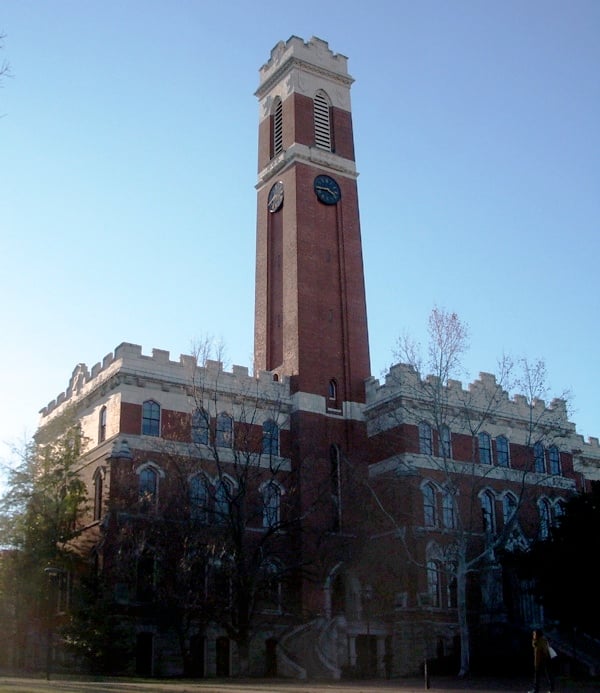
Vanderbilt University, Nashville
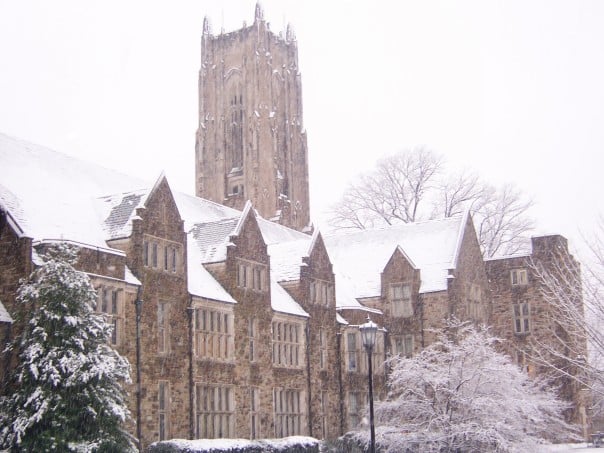
Rhodes College, Memphis

Tennessee State University, Nashville

Middle Tennessee State University, Murfreesboro
Tennessee has a rich variety of public, private, charter, and specialized education facilities ranging from pre-school through university education.
Colleges and universities
Public higher education is under the oversight of the Tennessee Higher Education Commission which provides guidance to two public university systems – the University of Tennessee system and the Tennessee Board of Regents. In addition a number of private colleges and universities are located throughout the state.
American Baptist College
Aquinas College
The Art Institute of Tennessee – Nashville
Austin Peay State University
Baptist College of Health Sciences
Belmont University
Bethel College
Bryan College
Carson–Newman University
Chattanooga State Community College
Christian Brothers University
Cleveland State Community College
Columbia State Community College
Crown College
Cumberland University
Dyersburg State Community College
East Tennessee State University
Emmanuel Christian Seminary
Fisk University
Freed–Hardeman University
Jackson State Community College
Johnson University
King University
Knoxville College
Lane College
Lee University
LeMoyne–Owen College
Lincoln Memorial University
Lipscomb University
Martin Methodist College
Maryville College
Memphis College of Art
Memphis Theological Seminary
Mid-America Baptist Theological Seminary
Middle Tennessee State University
Milligan College
Motlow State Community College
Nashville School of Law
Nashville State Community College
Northeast State Community College
O'More College of Design
Pellissippi State Community College
Rhodes College
Roane State Community College
Sewanee: The University of the South
Southern Adventist University
Southern College of Optometry
Southwest Tennessee Community College
Tennessee Colleges of Applied Technology
Tennessee State University
Tennessee Technological University
Tennessee Wesleyan University
Trevecca Nazarene University
Tusculum University
Union University
University of Memphis
University of Tennessee system University of Tennessee (Knoxville) University of Tennessee Health Science Center (Memphis) University of Tennessee Space Institute University of Tennessee at Chattanooga University of Tennessee at Martin
Volunteer State Community College
Walters State Community College
Watkins College of Art, Design & Film
Welch College
Williamson College
Local school districts
Public primary and secondary education systems are operated by county, city, or special school districts to provide education at the local level.
These school districts operate under the direction of the Tennessee Department of Education.
Private schools are found in many counties.
State symbols
State symbols, found in Tennessee Code Annotated; Title 4, Chapter 1, Part 3, include:
State amphibian – Tennessee cave salamander
State bird – mockingbird
State game bird – bobwhite quail
State butterfly – zebra swallowtail
State sport fish – smallmouth bass
State commercial fish – channel catfish
State cultivated flower – iris
State wild flowers – passion flower and Tennessee echinacea
State insects – firefly and lady beetle
State agricultural insect – honey bee
State wild animal – raccoon
State horse – Tennessee Walking Horse
State reptile – eastern box turtle
State firearm – Barrett M82[108]
State tree – tulip poplar
State evergreen tree – eastern red cedar
State beverage – milk
State dance – square dance
State fruit – tomato
State fossil – Pterotrigonia (Scabrotrigonia) thoracica
State gem – Tennessee River pearl
State mineral – agate
State rock – limestone
State motto – Agriculture and Commerce
State poem – "Oh Tennessee, My Tennessee" by Admiral William Lawrence
State slogan – Tennessee – America at its Best
State songs – nine songs
See also
Outline of Tennessee – organized list of topics about Tennessee
Index of Tennessee-related articles